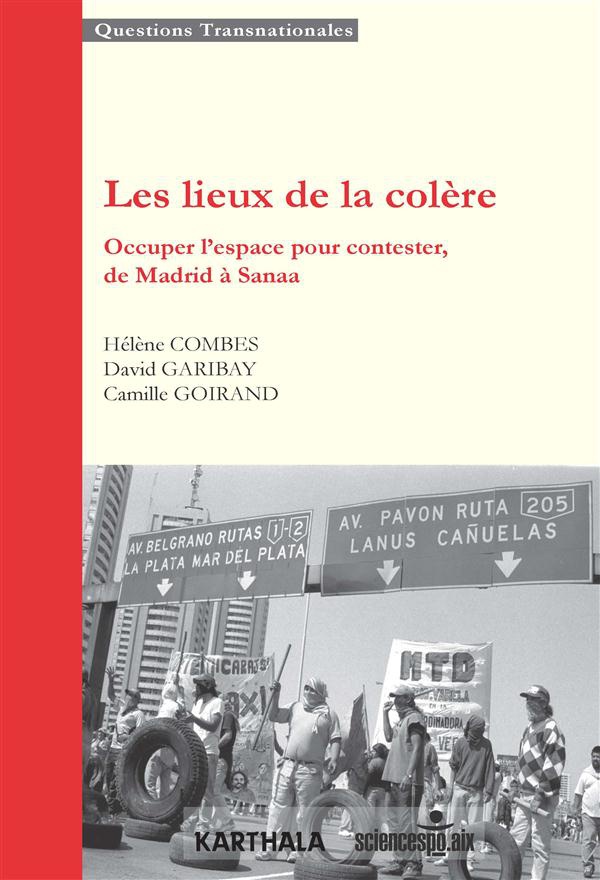Places of anger
Occupying space to protest, from Madrid to Sanaa
by Hélène COMBES, David GARIBAY and Camille GOIRAND
Summary
In many capitals, majestic squares, steeped in history and symbolism, are taken over by demonstrators: the students in Beijing's Tiananmen Square, the Indignés in Madrid's Puerta del Sol, the mothers of the disappeared in Buenos Aires' Plaza de Mayo, the protesters in Mexico City's Zócalo... This centrality of space in the construction of protest has been noted by many observers during the Arab revolts and the Occupy movement. Yet, despite this apparent evidence of place, the spatial dimension has rarely received attention as such in the sociology of mobilisation. This book tackles this blind spot. It invites readers to understand the importance of physical and lived places and their effects on collective action by following a wide variety of mobilisations - local or national, past or present, from the Arabian Peninsula to Brittany, from New York to Seine-Saint-Denis, from the Peruvian Amazon to Madrid.

Authors
Hélène Combes is a CNRS research fellow at the Centre de recherches internationales (CERI- UMR 7050), Sciences Po.
David Garibay is a professor of political science at the Université Lumière Lyon 2 and a researcher at UMR Triangle.
Camille Goirand is a professor of political science at the University of Paris 3 Sorbonne Nouvelle (Institut des hautes études d'Amérique latine - IHEAL) and a researcher at the Centre d'études et de recherches administratives, politiques et sociales (CERAPS - CNRS UMR 8026).
Other contributors to this book include : Anahi Alviso-Marino, Martin Baloge, Doris Buu-Sao, Franck Gaudichaud, Marie Laure Geoffray, Stéphanie Guyon, Tudi Kernalegenn, Aurélie Llobet, Julie Metais, Héloïse Nez, Sylvie Ollitrault, Charlotte Pujol, Stéphane Tonnelat.
Publication date
11/01/2016
Contents
Introduction: when space counts... Spatialising the analysis of mobilisations
Hélène COMBES, David GARIBAY, Camille GOIRAND
Part One - The symbolic construction of mobilisation through space
Turning a place into a political symbol. Committed photography on the Place du
change in Sanaa
Anahi ALVISO-MARINO
The Cuban street. Between repression, media coverage and transnationalisation
Marie Laure GEOFFRAY
Spatial registration of a workers' strike in Brittany. Le Joint français, Saint-
Brieuc, 1972
Tudi KERNALEGENN
Part Two - Spaces with militant identities
Ecologies of a space in revolution. Santiago de Chile, 1970-73
Franck GAUDICHAUD
Becoming an Indian in an urban environment. The commitments of young Amazonians in the
through the prism of its spatial anchorage
Doris BUU-SAO
From workspace to collective action. The case of secondary school teachers in France
Aurélie LLOBET
Part Three - Occupy, control, shape
Deliberating in the open air. Spatial analysis of the Indignados assemblies in Madrid
Héloïse NEZ
Controlling militant debate in the sections. Spatial organisation of Party meetings
socialist in France
Martin BALOGE
The career of an urban interstice in New York. Two distinct roles for space
in mobilising around a development project
Stéphane TONNELAT
Part four - Mobilisation in motion
Socio-spatial trajectories in a globalised world. Volunteers from
Greepeace and organic farmers in Brittany
Sylvie OLLITRAULT
From the union to the village, from the Zócalo to the Sierra. Teachers in struggle in Oaxaca
(Mexico)
Julie MÉTAIS
The mobilisation of the unemployed in Rosario (Argentina). A city in
movement
Charlotte PUJOL
Involvement in Amerindian and Businenge associations in French Guiana. Anchoring
local participation, customer relations and politicisation
Stéphanie GUYON
Reviews and speeches
Social linksReadings, 2016, Ellie Mevel.
REMM, Review of Muslim Worlds and the Mediterranean, 2018, n° 144, Sélim Smaoui.
"All in all, the book is fascinating and lives up to the promise made by the coordinators [...] the chapters reflect regularities as much as they add to the coherence of the volume. This is undoubtedly one of the book's strong points: the hypotheses are tested on events that are historically remote and are examined using a wide range of empirical situations (partisan sections, rural communities, factory occupations, school union sections, etc.)".
EMAM publications - Arab and Mediterranean StudiesRoman Stadnicki, 2016, no. 28.
"Few researchers have had the opportunity to observe the Yemeni revolution. Anahi Alviso-Marino did.
His ethnography of Change Square - the place where the 2011 demonstrations were held in reaction to the regime's blocking of access to Tahrir Square - shows that the strength of the protest movement is partly based on the demonstrators' desire to make this place - which is rather peripheral and, moreover, not identified as a square by the people of Sana'a - part of the collective representations.
[...]
Finally, we will appreciate the originality of certain approaches in which inventive methods such as landscape and iconographic analysis, social networking and street surveys coexist with more traditional social science methods such as participant observation and semi-structured interviews, generally revealing a very good understanding of spatially and temporally situated social mobilisations.
Politix, 2017, n° 117, Maurice Olive, p. 241-245.
Urban studies notebookLyon 2/ Triangle, 2016, Mathilde Girault.
JSSJ - Justice spatiale / Spatial justice, 2017, n° 11, Alex Mahoudeau.
IHEAL-CREDA Newsletter, 2017, n°2, " From the Plaza de la República to the Plaza del Sol: the symbols of protest. Focus on Places of anger. Occupying space to protest, from Madrid to Sanaa ".
Paul Cormier, 2016, " Geography of the struggle ", The life of ideas.
Arthur Guichoux, 2022, " Seat movements ", DicoPartedition 2.